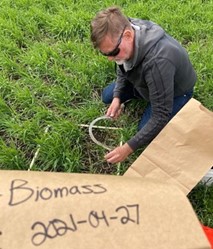Submitted by: Kelsey Banks, Agronomist, on behalf of Ottawa-Rideau Region
On-farm plots are planned every year with different data goals that the researchers and farmers want to obtain. Planning a plot is a lot of work, but it generally includes the following steps:
- Plot goal creation – what is this plot being planned for? Is it being planned as a marketing tool for a crop input or to gain research data for your own farm or for the product owner itself?
- Finding the plot location – if the plot is being planned with your agronomist and/or company representative that provides a product to trial, ask what their ‘dream field’ is for this product. Do they want a highly variable soil type field? Or other specifications?
- Finding out what equipment is available or required – how wide is the combine head? How wide is the planter? If the plot includes testing a fungicide, herbicide, insecticide, or another type of product applied via sprayer, how wide is the boom?
- Take the space of the plot location and the size of the equipment and create a plan that includes replication passes and variable pass placement throughout.
There are other factors to consider while planning a plot, such as topography and field history. Once the plot has been planned and seeded or planted, some are then left to grow and not scouted again until determining pre- harvest desiccant application timing. However, it is important to scout the plot as it grows, as this is when you may discover important information and gain valuable data in addition to final yield and quality when harvesting.
Scouting a plot in-season is like scouting a field that has a single crop plan dedicated to it but requires the same scouting protocol completed in a single crop plan field for each treatment in the plot. Typically, while scouting each treatment in the plot, it is important to note the following:

Scott Banks, agronomist, is taking a tissue sample to measure biomass of the cover crop from the different treatment points in one of the ONFARM Soil Health Project fields in Douglas, ON.
- Date and time of day of plot scout
- Weather at time of scouting
- Treatment number or name
- Plant growth stage
- Root health – Do the roots look healthy? Take a picture of each treatment to include in a post-scouting report.
- Signs of pests (weeds, insects, or diseases) – Where is it located? How many per square foot on average? Take pictures to include in a post-scouting report.
- Signs of plant growth disturbance – for example, signs of compaction running through one of the treatments from an ATV or side-by-side? If so, be sure to take note of this.
- Any other observations
It may sound like a lot of work to put together a post-scouting report, but you want to make sure you gain valuable and accurate data to predict future use of the product(s) being trialed on your farm. By taking the extra time to scout the plots and create a post-scouting report, you can then create some expectations of what to see during harvest. For example, if you harvest a treatment that consistently had a side-by-side driving through it and the yield was low compared to the other treated passes, you can make a note that the yield may have been impacted due to compaction. Also, scouting will give you an opportunity to make any additional recommendations and applications that need to be made to positively contribute to the yield and health of that crop.
It is important to keep watch of growth and note any differences you may notice during the season. Although yield and quality are important, a healthy growing season is needed as well! For any questions about scouting your on-farm trials, please speak to your local agronomist.